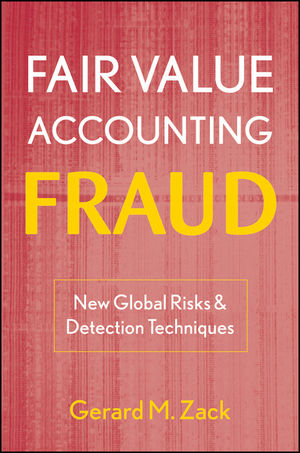Fair Value Accounting Fraud: New Global Risks and Detection TechniquesISBN: 978-0-470-47858-5
Hardcover
272 pages
August 2009
 This is a Print-on-Demand title. It will be printed specifically to fill your order. Please allow an additional 10-15 days delivery time. The book is not returnable.
|
||||||
Acknowledgments.
PART I INTRODUCTION TO FAIR VALUE ACCOUNTING FRAUD.
CHAPTER 1 Overview of Financial Statement Fraud and Fair Value Accounting.
Introduction to Financial Reporting Fraud.
What Makes It Fraud?
Why Financial Reporting Fraud Is Perpetrated.
Using One Fraud to Hide Another.
CHAPTER 2 The Use of Fair Value in Financial Statements.
Historical Cost versus Fair Value.
Sources of Accounting Principles.
U.S. GAAP versus IFRS.
Fair Value Option Added for U.S. GAAP.
Fair Value Defined.
International Convergence.
Some Principles of Financial Statement Presentation.
Effective Dates of Accounting Standards.
Impact of Fraud on Financial Statements.
CHAPTER 3 Methods of Determining Fair Value.
Introduction.
Market Approach.
Income Approach.
Cost Approach.
Internal versus Externally Developed Valuations.
Inputs to Valuation Methods.
Fair Value Guidance under IFRS.
Availability of Market Evidence.
PART II ASSET-BASED SCHEMES.
CHAPTER 4 Investments in Debt and Publicly Traded Equity Securities.
Scope of Investments Covered.
Sources of U.S. GAAP and IFRS.
Classification and Treatment—U.S. GAAP.
Classification and Treatment—IFRS.
Reclassifications in General.
Reclassifications from the Held-to-Maturity Category.
Determination of Fair Value.
Active versus Inactive Markets.
Temporary versus Other-than-Temporary Impairments—U.S. GAAP.
Impairment Losses—IFRS.
Summary of Fraud Risks.
CHAPTER 5 Ownership Interests in Nonpublic Entities.
Sources of U.S. GAAP and IFRS.
Introduction.
Consolidated Financial Statements.
Jointly Controlled Entities versus Jointly Controlled Assets.
Equity Method Investments.
Proportionate Consolidation.
Fair Value Option.
CHAPTER 6 Loans and Receivables.
Sources of U.S. GAAP and IFRS.
Recognition and Measurement—U.S. GAAP.
Recognition and Measurement—IFRS.
CHAPTER 7 Intangible Assets and Goodwill.
Sources of U.S. GAAP and IFRS.
Asset versus Expense.
Web Site Costs.
Measurement.
Finite Life Intangible Assets.
Residual Value.
Indefinite Life Intangible Assets.
Impairment Losses.
Concluding Remarks.
CHAPTER 8 Business Combinations.
Sources of U.S. GAAP and IFRS.
Business Combination versus Asset Acquisition.
Accounting for Business Combinations.
Identification of Intangible Assets.
Business Combinations Achieved in Stages.
CHAPTER 9 Asset Impairments.
Sources of U.S. GAAP and IFRS.
Definition of an Impairment Loss.
When to Test for Impairment.
Indicators of Impairment of Assets.
Extent of Impairment Loss.
Reversal of Previous Impairment Losses.
CHAPTER 10 Property and Equipment (Including Investment Properties).
Sources of U.S. GAAP and IFRS.
Initial Recognition.
Measurement after Initial Recognition.
Investment Property.
Impairment Losses.
PART III LIABILITY-BASED SCHEMES.
CHAPTER 11 Debt Obligations.
Sources of U.S. GAAP and IFRS.
Measurement.
Fair Value Option.
Valuation of Debt.
CHAPTER 12 Deferred Revenue.
Sources of U.S. GAAP and IFRS.
Recognition—Customer Loyalty Programs.
Multiple Deliverable Arrangements.
CHAPTER 13 Asset Retirement Obligations.
Sources of U.S. GAAP and IFRS.
Recognition—U.S. GAAP.
Recognition—IFRS.
Can a Reliable Estimate Be Determined?
Measuring and Recording an Asset Retirement Obligation.
Summary—Comparison of U.S. GAAP and IFRS.
CHAPTER 14 Guarantees.
Sources of U.S. GAAP and IFRS.
Recognition—U.S. GAAP.
Measurement.
Recognition—IFRS.
PART IV OTHER FAIR VALUE ACCOUNTING FRAUD ISSUES.
CHAPTER 15 Derivatives and Hedging.
Sources of U.S. GAAP and IFRS.
Definitions and Treatment—U.S. GAAP.
Definitions and Treatment—IFRS.
Measurement.
Embedded Derivatives.
CHAPTER 16 Assets or Liabilities of Sponsors of Employee Benefit Plans.
Sources of U.S. GAAP and IFRS.
Recognition and Measurement—U.S. GAAP.
Recognition and Measurement—IFRS.
CHAPTER 17 Contingencies and Provisions.
Sources of U.S. GAAP and IFRS.
Recognition—U.S. GAAP.
Amount of Loss to Be Recognized.
Recognition—IFRS.
Measurement.
Comparison of U.S. GAAP and IFRS.
CHAPTER 18 Share-Based Transactions.
Sources of U.S. GAAP and IFRS.
Recognition—U.S. GAAP.
Measurement—U.S. GAAP.
Recognition—IFRS.
Measurement—IFRS.
CHAPTER 19 Nonmonetary Transactions.
Sources of U.S. GAAP and IFRS.
Recognition and Measurement—U.S. GAAP.
Recognition and Measurement—IFRS.
Advertising Barter Transactions—U.S. GAAP.
Advertising Barter Transactions—IFRS.
CHAPTER 20 Special Fair Value Issues of Not-for-Profit Organizations.
Introduction.
Noncash Contributions of Assets.
Contributed Use of Assets.
Promises to Give.
Contributed Services.
Matching Requirements.
CHAPTER 21 Fair Value Disclosure Issues.
Introduction.
Sources of Disclosure Requirements.
Financial Instruments.
Impairment Losses.
Uncertainties.
PART V DETECTION OF FAIR VALUE ACCOUNTING FRAUD.
CHAPTER 22 A Framework for Detecting Fair Value Accounting Fraud.
Assessing the Risk of Fraud.
Understanding How Fair Value Impacts the Financial Statements.
External Factors that Indicate Risk.
Internal Risk Factors.
Materiality.
Internal Controls over Fair Value Accounting.
The Risk of Management Override.
Framework for Fair Value Accounting Fraud Detection.
Auditing Standards.
Auditor Independence.
CHAPTER 23 Use of Ratios and Other Analytical Procedures.
Analytical Procedures as a Fraud Detection Tool.
Horizontal Analysis.
Vertical Analysis.
Operating Ratios.
Customized Ratios.
Appendix A Summary Checklist of Fair Value Accounting Fraud Risks.
Appendix B SEC Office of the Chief Accountant and FASB Staff Clarifications on Fair Value Accounting.
Appendix C Internal Controls over Fair Value Accounting Applications.
Bibliography.
About the Author.
Index.



